
EOLO PONS--On Technique. BIDDINGTON'S CONTEMPORARY ART GALLERY--Paintings & Sculpture

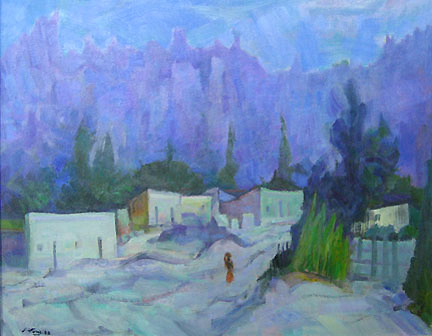
EOLO PONS
Argentine Painter
BIDDINGTON'S CREATIVE PROCESS interviews artist
Eolo Pons in his Buenos Aires studio.
CURRENT EXHIBITION:
Former Students of Instituto Argentina de Artes Gráficas 1934-1939
Featuring Works of Eolo Pons & Leopoldo Presas
Sept. 13-Oct. 5, 2007
Gutenberg Foundation
Belgrano 4299, Buenos Aires, Argentina
Editor's Note: Born in 1914 with an exhibition career spanning from the 1930's to the present, Eolo Pons is a living master of painting. His art grows from roots in rigorous technical training in drawing, color and composition brought to life with the mysterious spirit of Surrealism. Far from being mired in the past, Eolo Pons approaches each new painting with fresh eyes, an acute and cultivated intellect and a gifted hand.
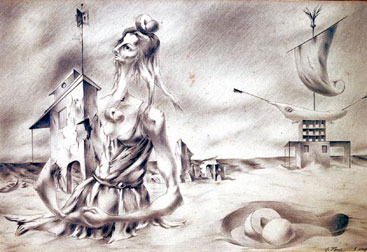
Eolo Pons: Painting comes from nature, memory and imagination.
Eolo Pons: Before immigrating to Argentina, my grandfather had studied art in Barcelona. My father drew as well, although he worked in a design studio making women's hats. As a kid, I always drew, but I had intended to become an engineer. In 1930, the economic crisis hit Argentina with a tremendous blow; that event changed everyone's plans. So, I quit school to help earn a living for our family. While employed in a commercial shop stamping and cutting metal for jewelry, I happened to show another young co-worker my drawings. He said he had a brother who was a painter and asked if I would like to meet him. When his brother the artist Onofrio Pacenza saw my sketches, he suggested I take the entrance exam for the Academy of Fine Arts. I hadn't even known that such a place existed here.
Eolo Pons "España Tell" (Homage to José Planas Casas)
Surrealist Pencil Drawing, 1939
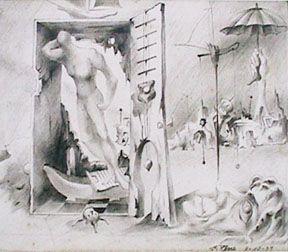
Eolo Pons: At the Academia de Bellas Artes Manuel Belgrano, I had the good luck to get Clorindo Trecchini as a drawing instructor. There I began learning basic skills: about using charcoal, about drawing from gessoes and from models. Unfortunately, the school was poorly managed, and the classes were very large. The 1930's were a time of social turmoil, political activity and strikes. So, in the middle of my third year, a student strike closed the academy. After a hiatus of several months, several of us including my friends Leopoldo Presas and Luis Lusnich decided to go study with Lino Anea Spilimbergo at the Instituto Argentino de Artes Gráficas where I attended studio classes from 1935-38.
Eolo Pons "Destruccion"
Surrealist Pencil Drawing, 1939
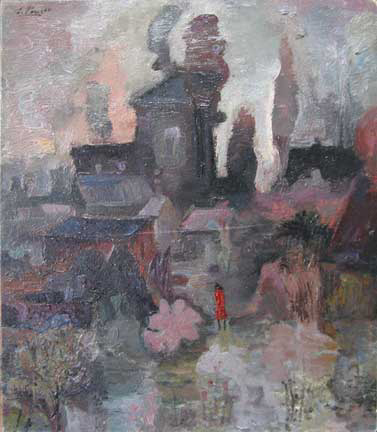
Eolo Pons: Spilimbergo was a great teacher. The aspect I admired most about Spilimbergo was his respect for his students: he treated us as equals and was a humble man--not a tyrannical maestro. Studying with Spilimbergo was like being bounced off a trampoline: he launched each student on his own individual trajectory.
Eolo Pons Nocturno
Oil on Panel, 1964
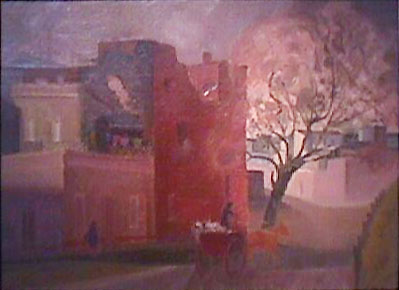
Eolo Pons: During this period (the late 1930's) I made Surrealist drawings and paintings. Among our group there had been a lot of discussion about whether or not this European movement could have meaning for us in Argentina. Spilimbergo said: "Surrealism? Why not? But always with the accent of the Plaza de Mayo."
Editor's Note: The Plaza de Mayo is the main public square in Buenos Aires.
Eolo Pons Calle Nueva Pompeya
Oil on Panel, 1972
Private Collection, New York
Eolo Pons: In Europe, Dalí was making Surrealist works with the feeling of Spain. Surrealism here in Argentina was more theoretical, and it was also more related to the mysteries of nature---the mysteries of creation. At this same time (late 30's-early 40's), I also worked in a printmaking studio with José Planas Casas, Pompeyo Audivert and Juan Batlle Planas all of whom, like me, had a Catalan heritage and a Surrealist bent. In 1945, I met the painter Carlos Giambiagi who became both my mentor and my great friend. Giambiagi was an extraordinarily cultivated person in all respects. He lived on a ranch up in Misiones. We carried on a correspondence for more than 10 years; from time to time we traveled and painted together in northern Argentina. From Giambiagi, I learned what it means to be an artist. Editor's Note: If there are painters who think and thinkers who paint, then Carlos Giambiagi (1887-1965) falls into the second category. A collection of his writings and correspondence "Reflexiones de un pintor" (Reflections of a Painter), representing a lifetime of thinking about the role of the artist and art in society, was published posthumously in 1972.
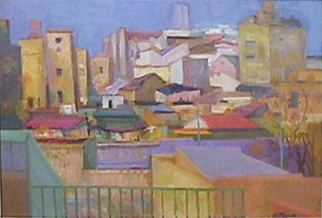
Eolo Pons: In 1939, the French sent 200 paintings from the Louvre museum to Buenos Aires: Cezannes, Van Goghs, Monets. I was excited because these were works I knew only from poor reproductions in books. Of course, I went immediately to see the collection. When I got there, I said to myself: "This is the famous Cezanne?" I felt so letdown. Cezanne's paintings just didn't strike me; they seemed bland--certainly compared to the Van Goghs. But there was a lot to see, so I kept going back. After a few months, Van Gogh and the others diminished in my appreciation and Cezanne won. (Of course, Van Gogh is major.) Over time, I always encountered in Cezanne something more interesting.
Editor's Note: In anticipation of war, the French sent a large group of masterpieces abroad in an extended traveling exhibition entitled "De David à Nos Jours" (From David to the Present). After its stay in Argentina, the show moved to the US where the works remained until the end of World War II. In 1946, these cultural treasures were safely returned to France.
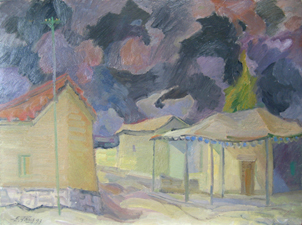
Eolo Pons: That's when I learned that art is not entertainment. Art is not about making a big spectacle. A painting, if it is art, gives you something new each time you look at it. Art is about delving deeper. Art is profound. You don't apprehend depth in just one glance.
Eolo Pons Presagio
Oil on Panel, 1993
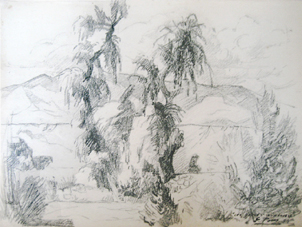
Eolo Pons: Whether artist or viewer, you have to cultivate your sensibilities so that you can be receptive to what is being expressed. Of course, sometimes you look and look, and there is nothing to see. Not all painting is art.
Eolo Pons Humahuaca
Pencil Drawing, 1959
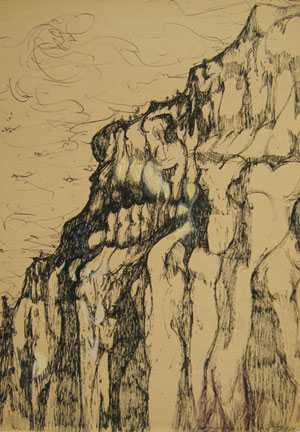
Eolo Pons: This is the battle the artist has: You always have to keep working and learning so that you have something to say and can effectively convey what you see or feel. When I look at nature--and my whole surroundings is nature--it's telling me something. It's my job to put that down on canvas and to communicate it to the viewer.
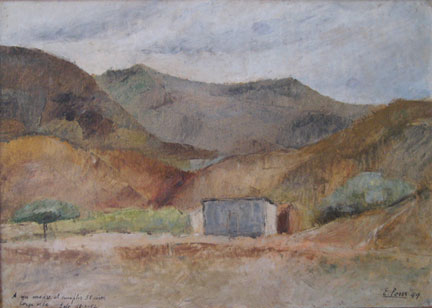
Eolo Pons: As a kid from the neighborhoods in Buenos Aires, when I traveled to the north in 1949, it awakened something in me. In those days, a train ran all the way to the Bolivian border. Whenever it slowed down, I would see people here and there just sitting quietly in the open air looking around them. They were part of the landscape. I learned that landscape and people are inseparable.
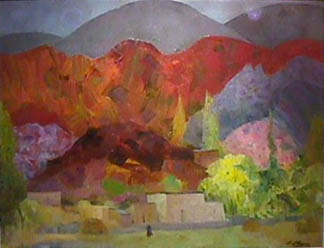
Eolo Pons: I've never been interested in adhering to any special group or any "-ism". Here is Argentina we receive styles with some delay, so we're always a little behind the fashion anyway. Surrealism, cubism, abstraction, these are ways of responding to nature. To some extent, they're all useful ideas.
Eolo Pons: Look at the indigenous art of the Andes: In some periods the painting is representational & descriptive and in other periods it becomes abstract & symbolic. The pendulum swings: a painter is always navigating between two waters.
The important thing is not whether a painting is realist or abstract, the important thing is whether it is, or is not, art.
Eolo Pons: The current art world is difficult because it has become mercantilized. Many art dealers are actually merchants who promote people whose work sells readily; these dealers encourage their painters to keep working in the same way--essentially to copy their own paintings. I don't criticize those who choose to do this, but the item being sold is a product--it is not art.
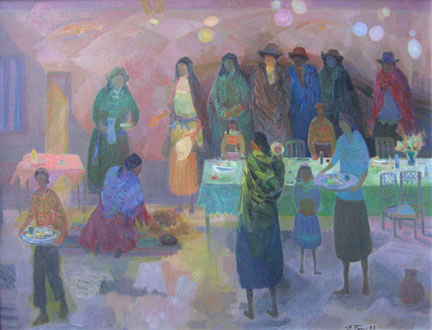
Eolo Pons La Flechada
Oil on Canvas, 1993
Eolo Pons: Art is culture. Culture modifies our bestiality and helps human beings co-exist. Art crosses frontiers and transcends time.
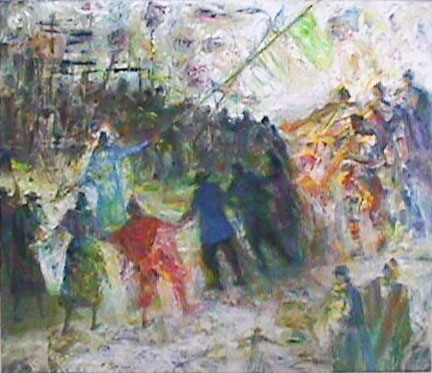
Eolo Pons "Comparsa"
Oil on Canvas, 2006
Eolo Pons: When my friends or students don't know where to go with their work, I urge them to go to the source: Look at Masaccio, look at Rembrandt, look at African art, look at Malevich. There is always something to be drawn from the stream. You know, at the end of his life, Malevich made sublime figurative paintings--essentially realist in style. The art critics and historians prefer to forget this. They don't like complexities.
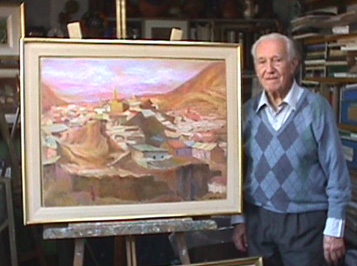
Eolo Pons: Whenever I begin a painting, not only do I set out to make my painting better, I set out to make my life better. Art is my vocation. I'm not sure that I am an artist, but I always try to be one.
Eolo Pons
in His Studio in 2006
with Painting "Potosi"
See also:
EOLO PONS--On Technique.
Landscape at beginning of article:
Calle de Tilcara
Oil Painting, 1999
ABOUT THIS FEATURE
CREATIVE PROCESS at Biddington's is designed as a forum for watching art in the making. Usually, this process happens in the privacy of the artist's studio. At BIDDINGTON'S Contemporary Art Gallery, we find it interesting to witness the steps leading to the end product and to hear the artists speak about their work in the relaxed surroundings of their own studios.
Email Biddington's with your comments.
BIDDINGTON'S CREATIVE PROCESS Archives:
Sigmund Abeles Expressive Realist Painter
Javier Astorga Figurative Metal Sculpture
Nancy Azara Sculptor
Tova Beck-Friedman Sculptor & Mixed-Media Artist
Todd Bellanca Abstract Painter
Carol Bruns Bronze Figurative Sculptor
James Burnett Non-Objective Painter
Cynthia Capriata Peruvian Painter & Printmaker
Catalina Chervin Argentine Surrealist Artist
Diane Churchill Expressionist Painter
John Clem Clarke Pop Artist
Lisa Dinhofer Illusionist Painter
Michael Eastman Faux-Primitive Painter
Lynne Frehm New York Abstract Painter
Betsey Garand Minimalist Painter & Fine Art Printmaker
Mary Teresa Giancoli Personal Documentary Photographer
Debora Gilbert-Ryan New Image Painter
Janet Goldner African-Influenced Steel Sculpture
Harry Gordon Monumental Sculpture
Patricia Hansen Portrait and Still Life Painter
Richard Heinrich Welded Steel Sculpture
Charles Hewitt Painter & Monotype Printmaker
Diane Holland Intermedia Collage Artist
GH Hovagimyan Pop/Conceptual Artist
LA Hughes Pop Artist
Frances Jetter Bronze Sculptor & Editorial Illustrator
Scott Kahn Fantasy Painter
Susan Kaprov Digital Printmaker and Abstract Painter
Babette Katz Narrative Printmaker and Book Artist
Richard Mock Abstract Painter & Linocut Printmaker
Bill Murphy Contemporary Realist Painter
Jim Napierala Abstract Painter
Frances Pellegrini New York City & Fashion Photographer
Eolo Pons Argentine Master
Joseph Reeder Cross Media Artist Paintings & Ceramics
Laura Shechter Contemporary Realist Painter
Annemarie Slipper Figurative Ceramic Sculpture
Gary Slipper Fantasy Painter
Margaret Speer Landscape & Travel Paintings
Serena Tallarigo Marble Sculptor
Rein Triefeldt Kinetic Sculpture
Vivian Tsao Painter of Light
Nancy Van Deren Contemporary Painter
Joan Berg Victor Drawings from Nature
Edward Walsh Figurative Sculpture in Bronze, Marble & Steel
Kate Wattson Contemporary Colorist Painter
Betty Winkler Organic Minimalist Painter & Printmaker
COPYRIGHT: Images and information within www.biddingtons.com are Copyright Biddington's, Inc.--except where preceded by individual copyrights of the artists.
Downloading or printing for online or print reproduction of any materials without specific written permission from Biddington's, Inc. is prohibited.
PEDIGREE & PROVENANCE--art words & terms defined.
JAKE BIDDINGTON'S INVESTING--financial advice for art collectors.
BIDDINGTON'S BENTLEY--travel for the art & antiques connoisseur. MY ART--Art for kids.


















